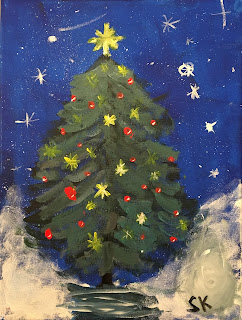This was the final project for my little kids class (ages 6-7) before the winter break. It was a power lesson turned up to high speed! We did this beautiful project in under 90 minutes.
It was a step by step process where I demonstrated each step, before the kids followed the step on their own.
Process: Students collaged sheets of old book paper and sheet music paper onto multipurpose paper using an old brush and acrylic gel medium. We gave our collage paper a top coat of gel medium, and dried it using a blow dryer. Next we spritzed a few spritzes of blue-green paint on our paper which I had premixed and put in a spritz bottle, diluted with plenty of water to ensure it spritzes nicely. We dried this. Next, we used bubble wrap to stamp some white snow all over our paper (we applied white paint to our bubble wrap using a brush). We put these background papers aside.
On another paper, we drew a large triangle. We laid down strips of green patterned paper (which I had pre-cut) on our triangle, being sure to line up each strip with the next, or slightly overlap, so as not to leave any paper peeking through. We used gel medium to collage the strips, ensuring to put a layer of gel medium over top each strip too (under and over, is the rule for gel medium). We dried these, then cut out our triangle tree.
Next, we drew our very own star on yellow paper. Some of us practiced this a few times, before working on our yellow paper. We glued our tree on our collage background, then glued our star on top. Next, we make presents using squares and rectangles of patterned paper, and cut very thin strips of contrasting paper which we glued on top like ribbons. We glued these in a heap under our tree.
We dried everything with a hair dryer. Using soft vine charcoal, we went along the edges of all our objects (tree, star, presents) and smudged with our fingers to give our art some depth and dimension. Lastly, we used a wooden stamp and stamped a few times around our paper. We also stamped in the date using a date stamp, so we never ever forget what day and year it was when our little creative hands made these beautiful christmas trees.























































